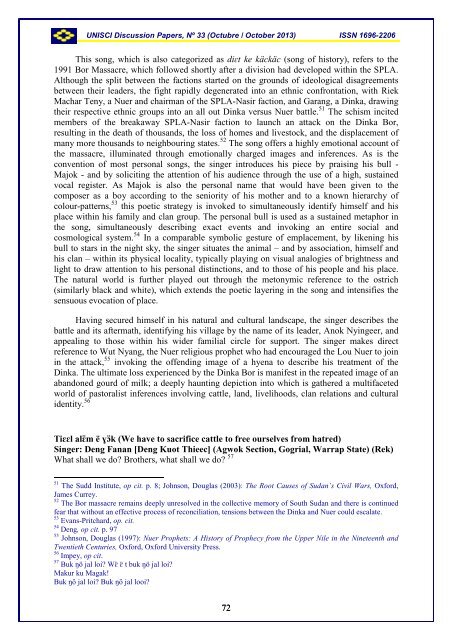UNISCI - Universidad Complutense de Madrid
UNISCI - Universidad Complutense de Madrid
UNISCI - Universidad Complutense de Madrid
You also want an ePaper? Increase the reach of your titles
YUMPU automatically turns print PDFs into web optimized ePapers that Google loves.
<strong>UNISCI</strong> Discussion Papers, Nº 33 (Octubre / October 2013) ISSN 1696-2206This song, which is also categorized as diɛt ke käckäc (song of history), refers to the1991 Bor Massacre, which followed shortly after a division had <strong>de</strong>veloped within the SPLA.Although the split between the factions started on the grounds of i<strong>de</strong>ological disagreementsbetween their lea<strong>de</strong>rs, the fight rapidly <strong>de</strong>generated into an ethnic confrontation, with RiekMachar Teny, a Nuer and chairman of the SPLA-Nasir faction, and Garang, a Dinka, drawingtheir respective ethnic groups into an all out Dinka versus Nuer battle. 51 The schism incitedmembers of the breakaway SPLA-Nasir faction to launch an attack on the Dinka Bor,resulting in the <strong>de</strong>ath of thousands, the loss of homes and livestock, and the displacement ofmany more thousands to neighbouring states. 52 The song offers a highly emotional account ofthe massacre, illuminated through emotionally charged images and inferences. As is theconvention of most personal songs, the singer introduces his piece by praising his bull -Majok - and by soliciting the attention of his audience through the use of a high, sustainedvocal register. As Majok is also the personal name that would have been given to thecomposer as a boy according to the seniority of his mother and to a known hierarchy ofcolour-patterns, 53 this poetic strategy is invoked to simultaneously i<strong>de</strong>ntify himself and hisplace within his family and clan group. The personal bull is used as a sustained metaphor inthe song, simultaneously <strong>de</strong>scribing exact events and invoking an entire social andcosmological system. 54 In a comparable symbolic gesture of emplacement, by likening hisbull to stars in the night sky, the singer situates the animal – and by association, himself andhis clan – within its physical locality, typically playing on visual analogies of brightness andlight to draw attention to his personal distinctions, and to those of his people and his place.The natural world is further played out through the metonymic reference to the ostrich(similarly black and white), which extends the poetic layering in the song and intensifies thesensuous evocation of place.Having secured himself in his natural and cultural landscape, the singer <strong>de</strong>scribes thebattle and its aftermath, i<strong>de</strong>ntifying his village by the name of its lea<strong>de</strong>r, Anok Nyingeer, andappealing to those within his wi<strong>de</strong>r familial circle for support. The singer makes directreference to Wut Nyang, the Nuer religious prophet who had encouraged the Lou Nuer to joinin the attack, 55 invoking the offending image of a hyena to <strong>de</strong>scribe his treatment of theDinka. The ultimate loss experienced by the Dinka Bor is manifest in the repeated image of anabandoned gourd of milk; a <strong>de</strong>eply haunting <strong>de</strong>piction into which is gathered a multifacetedworld of pastoralist inferences involving cattle, land, livelihoods, clan relations and culturali<strong>de</strong>ntity. 56Tiɛɛl alɛ̈ m ë ɣɔ̈ k (We have to sacrifice cattle to free ourselves from hatred)Singer: Deng Fanan [Deng Kuot Thieec] (Agwok Section, Gogrial, Warrap State) (Rek)What shall we do? Brothers, what shall we do? 5751 The Sudd Institute, op cit. p. 8; Johnson, Douglas (2003): The Root Causes of Sudan’s Civil Wars, Oxford,James Currey.52 The Bor massacre remains <strong>de</strong>eply unresolved in the collective memory of South Sudan and there is continuedfear that without an effective process of reconciliation, tensions between the Dinka and Nuer could escalate.53 Evans-Pritchard, op. cit.54 Deng, op cit. p. 9755 Johnson, Douglas (1997): Nuer Prophets: A History of Prophecy from the Upper Nile in the Nineteenth andTwentieth Centuries, Oxford, Oxford University Press.56 Impey, op cit.57 Buk ŋö jal loi? Wɛ̈ ɛ̈ t buk ŋö jal loi?Makur ku Magak!Buk ŋö jal loi? Buk ŋö jal looi?72
















